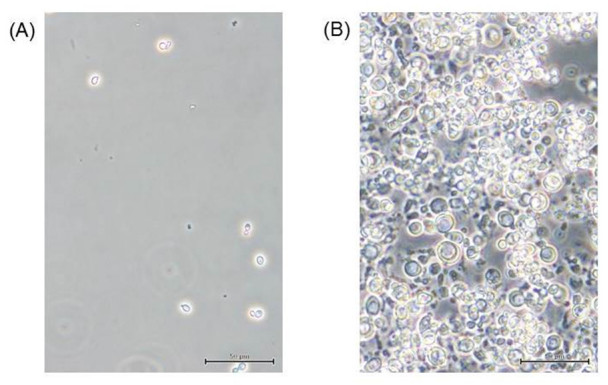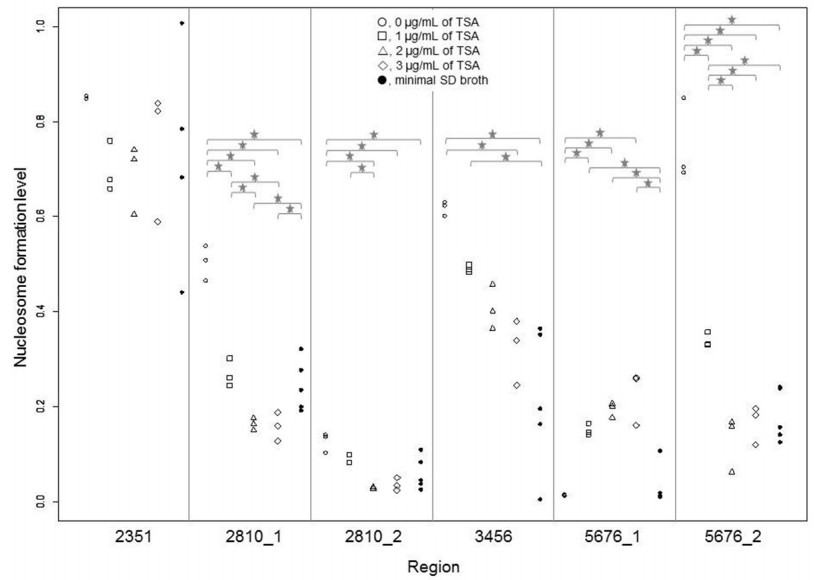We measured the degree of nucleosome formation at the gene promoters in trichostatin A-treated (1, 2, and 3 μg/mL) cells of the archiascomycete Saitoella complicata and those in enlarged S. complicata cells after zymolyase treatment. TSA-treated and enlarged cells showed similar changes in nucleosome occupancy in five out of six positions in the gene promoters. These results suggest that changes in nucleosome formation at the gene promoters could serve as stress response mechanisms elicited in response to spheroplast (zymolyase treatment) and TSA treatment. In addition, we demonstrated that changes in nucleosome position occurred mainly in cells treated with 1 μg/mL TSA, whereas cells treated with 2 and 3 μg/mL TSA did not exhibit significant changes in the degree of nucleosome formation.
1.
Introduction
Consider the following mth degree homogeneous polynomial of n variables f(x) as
where x=(x1,x2,⋯,xn)∈Rn. When m is even, f(x) is called positive definite if
The homogeneous polynomial f(x) in (1.1) can be expressed as the tensor product of a symmetric tensor A with m-order, n-dimension and xm defined by
where
C(R) presents complex (real) number fields. The symmetric tensor A is called positive definite if f(x) in (1.2) is positive definite [1]. Moreover, a tensor I=(δi1i2⋯im) is called the unit tensor[2], where
The positive definiteness of tensor has received much attention of researchers' in recent decade [3,4,5]. Based on the Sturm theorem, the positive definiteness of a multivariate polynomial form can be checked for n≤3 [6]. For n>3 and m≥4, it is difficult to determine the positive definiteness of f(x) in (2). Ni et al.[1] provided an eigenvalue method for identifying positive definiteness of a multivariate form. However, all the eigenvalues of the tensor are needed in this method, thus the method is not practical when tensor order or dimension is large.
Recently, based on the criteria of H-tensors, Li et al.[7] provided a practical method for identifying the positive definiteness of an even-order symmetric tensor. H-tensor is a special kind of tensors and an even order symmetric H-tensor with positive diagonal entries is positive definite. Due to this, we may identify the positive definiteness of a tensor via identifying H-tensor. For the latter, with the help of generalized diagonally dominant tensor, various criteria for H-tensors and M-tensors is established [8,9,10,11,12,13,14,15,16], which only depends on the elements of the tensors and is more effective to determine whether a given tensor is an H-tensor (M-tensor) or not. For example, the following result is given in [16]:
Theorem 1. Let A=(ai1⋯im) be a complex tensor with m-order, n-dimension. If
then A is an H-tensor.
In this paper, we continue to present new criterions based on H-tensors for identifying positive definiteness of homogeneous polynomial forms. The obtained results extend the corresponding conclusions [16,17,18]. The validity of our proposed methods are theoretically guaranteed and the numerical experiments show their effciency.
2.
Preliminaries
In this section, some notation, definitions and lemmas are given.
Let S be a nonempty subset of N={1,2,⋯,n} and let N∖S be the complement of S in N. Given an m-order n-dimension complex tensor A=(ai1⋯im), we denote
In this paper, we always assume that neither N1 or N2 is empty. Otherwise, we assume that A satisfies: aii⋯i≠0,Λi(A)≠0,∀i∈N.
we may define the following structured tensors extended from matrices.
Definition 1. [10] Let A=(ai1i2⋯im) be an m-order n-dimension complex tensor. A is called an H-tensor if there is a positive vector x=(x1,x2,⋯,xn)T∈Rn such that
Definition 2. [2] An m-order n-dimension complex tensor A=(ai1i2⋯im) is called reducible if there exists a nonempty proper index subset I⊂N such that
Otherwise, we say A is irreducible.
Example 1. Consider the 4-order 4-dimension tensor A given
and zero elsewhere. Then ai1i2i3i4=0 for all i1∈{1,4} and for all i2,i3,i4∈{2,3}. From Definition 2, we have that A is reducible.
Definition 3. [12] Let A=(ai1i2⋯im) be an m-order n-dimension complex tensor, for i,j∈N(i≠j), if there exist indices k1,k2,⋯,kr with
where k0=i,kr+1=j, we call that there is a nonzero elements chain from i to j.
It is shown that for any H-tensor, there exists at least one strictly diagonally dominant row [7]. Further, we have the following conclusion.
Lemma 1. [10] If A is a strictly diagonally dominant tensor, then A is an H-tensor.
Lemma 2. [7] Let A=(ai1⋯im) be a complex tensor with m-order, n-dimension. If there exists a positive diagonal matrix X such that AXm−1 is an H-tensor, then A is an H-tensor.
Lemma 3. [7] Let A=(ai1⋯im) be a complex tensor with m-order, n-dimension. If A is irreducible,
and strictly inequality holds for at least one i, then A is an H-tensor.
Lemma 4. [12] Let A=(ai1⋯im) be a complex tensor with m-order, n-dimension. If
● (i) |aii⋯i|≥Λi(A),∀i∈N,
● (ii) N3={i∈N:|aii⋯i|>Λi(A)}≠∅,
● (iii) For any i∉N3, there exists a nonzero elements chain from i to j such that j∈N3,
then A is an H-tensor.
3.
Criteria for identifying H-tensors
In this section, we give some new criteria for H-tensors.
Theorem 2. Let A=(ai1⋯im) be a complex tensor with m-order, n-dimension. If for i∈N2,
and for i∈N1, |aii⋯i|≠∑i2i3⋯im∈Nm−10δii2⋯im=0|aii2⋯im|, then A is an H-tensor.
Proof. From the definition of q, we know that 0≤q<1, q≥Λi(A)−|aii⋯i|Λi(A)(∀i∈N2), so for any i∈N3,
that is
By the definition of Pi(A), we have
For any i∈N3, from Inequality (3.2) and 0≤t≤1, we conclude that
For any i∈N2, by Inequality (3.1), it holds that
By Inequality (3.3) and Inequality (3.4), there exists a sufficiently small positive number ε such that
and
that is,
By the definition of t, it holds that
that is
Let the matrix D=diag(d1,d2,⋯,dn), and denote B=ADm−1=(bi1i2⋯im), where
For any i∈N1, by q>tPi(A)|aii⋯i|(∀i∈N3), we conclude that
For ∀i∈N2, by Inequality (3.6), then
Finally, for any i∈N3, by Inequality (3.7), thus
Therefore, we obtain that |bii⋯i|>Λi(B)(∀i∈N). From Lemma 1, B is an H-tensor. Further, by Lemma 2, A is an H-tensor.
Remark 1. From Theorem 2, we conclude that 0≤p<1, 0≤t≤1, and for any i∈N3,
Thus, all conditions in Theorem 2 are weaker than that in Theorem 1. Example 2 illustrates the superiority of Theorem 2.
Theorem 3. Let A=(ai1⋯im) be a complex tensor with m-order, n-dimension. If A is irreducible, and for all i∈N2,
and at least one strict inequality in (3.8) holds, then A is an H-tensor.
Proof. Notice that A is irreducible, this implies that for any i∈N3, Pi(A)>0, t>0 (Otherwise, A is reducible).
For any i∈N2, by Inequality (3.8), we obtain
Let the matrix D=diag(d1,d2,⋯,dn), denote B=ADm−1=(bi1i2⋯im), where
For any i∈N1, by q>tPi(A)|aii⋯i|(∀i∈N3), we conclude that
For any i∈N2, by Inequality (3.9), it holds that
Next, for any i∈N3, by Inequality (3.7), then
Therefore, |bii⋯i|≥Λi(B) (∀i∈N), and for all ∀i∈N2, at least one strict inequality in (10) holds, that is, there exists an i0∈N2 such that |bi0i0⋯i0|>Λi0(B).
On the other hand, since A is irreducible and so is B. Then, by Lemma 3, we have that B is an H-tensor. By Lemma 2, A is also an H-tensor.
Let
Theorem 4. Let A=(ai1⋯im) be a complex tensor with m-order, n-dimension. For any i∈N2,
and if for any i∈N∖K(A)≠∅, there exists a nonzero elements chain from i to j such that j∈K(A)≠∅, then A is an H-tensor.
Proof. Let the matrix D=diag(d1,d2,⋯,dn), and denote B=ADm−1=(bi1i2⋯im), where
A similar argument to that of Theorem 2, we can prove that |bii⋯i|≥Λi(B)(∀i∈N), and there exists at least an i∈N2 such that |bii⋯i|>Λi(B).
On the other hand, if |bii⋯i|=Λi(B), then i∈N∖K(A), by the assumption, we know that there exists a nonzero elements chain of A from i to j, such that j∈K(A). Hence, there exists a nonzero elements chain of B from i to j, such that j satisfying |bjj⋯j|>Λj(B).
Based on above analysis, we get that B satisfies the conditions of Lemma 4, so B is an H-tensor. By Lemma 2, A is an H-tensor.
Example 2. Consider the 3-order 3-dimension tensor A=(aijk) defined as follows:
Obviously,
so N1=∅,N2={1},N3={2,3}. By calculations, we have
When i=1, we get
so A satisfies the conditions of Theorem 2, then A is an H-tensor. However,
so A does not satisfy the conditions of Theorem 1.
4.
An application: the positive definiteness of homogeneous polynomial forms
Based on the criteria of H-tensors in Section 3, we present some criteria for identifying the positive definiteness of an even-order real symmetric tensor. First, we recall the following lemma.
Lemma 5. [7] Let A=(ai1i2⋯im) be an even-order real symmetric tensor with m-order, n-dimension, and ak⋯k>0 for all k∈N. If A is an H-tensor, then A is positive definite.
From Theorems 2−4 and Lemma 5, we obtain easily the following result.
Theorem 5. Let A=(ai1i2⋯im) be an even-order real symmetric tensor with m-order, n-dimension, and aii⋯i>0 for all i∈N. If one of the following holds:
● (i) A satisfies all the conditions of Theorem 2,
● (ii) A satisfies all the conditions of Theorem 3,
● (iii) A satisfies all the conditions of Theorem 4,
then A is positive definite.
Example 3. Let
be a 4th-degree homogeneous polynomial. We can get the 4-order 4-dimension real symmetric tensor A=(ai1i2i3i4), where
and zero elsewhere. By calculations, we have
and
Then A is not strictly diagonally dominate as defined in [17] or quasidoubly strictly diagonally dominant as defined in [18]. Hence, we cannot use Theorem 3 in [17] and Theorem 4 in [18] to identify the positive definiteness of A. However, it can be verified that A satisfies all the conditions of Theorem 2.
so N1=∅,N2={1},N3={2,3,4}. By calculations, we have
When i=1, we get
Therefore, from Theorem 5, we have that A is positive definite, that is, f(x) is positive definite.
5.
Conclusions
In this paper, we given some inequalities to identify whether a tensor is an H-tensor, which was also used to identify the positive definiteness of an even degree homogeneous polynomial f(x)≡Axm. These inequalities were expressed in terms of the elements of A, so they can be checked easily.
Acknowledgments
The authors wish to give their sincere thanks to the anonymous referees for their valuable suggestions and helpful comments, which help improve the quality of the paper significantly. This work was supported by the National Natural Science Foundation of China (11861077), the Foundation of Science and Technology Department of Guizhou Province (20191161, 20181079), the Talent Growth Project Department of Guizhou Province ([2016]168) and the Research Foundation of Guizhou Minzu University (2019YB08).
Conflict of interest
The authors declare that they have no competing interests.















 DownLoad:
DownLoad: